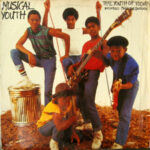 Supergrass wasn’t just another Britpop band. While they shared the scene with the likes of Blur, Oasis, and Pulp, Supergrass had something different. They had a raw, youthful energy that blended power-pop hooks with raucous garage rock, making them a staple of British rock throughout the 1990s and 2000s. Supergrass was more than the sum of its parts; they represented a time in music when everything felt possible and any corner of creativity was fair game.
Supergrass wasn’t just another Britpop band. While they shared the scene with the likes of Blur, Oasis, and Pulp, Supergrass had something different. They had a raw, youthful energy that blended power-pop hooks with raucous garage rock, making them a staple of British rock throughout the 1990s and 2000s. Supergrass was more than the sum of its parts; they represented a time in music when everything felt possible and any corner of creativity was fair game.
Their journey through the music industry, from the iconic debut album I Should Coco to their eventual disbandment in 2010, was a rollercoaster of highs and lows, from critical acclaim to shifting tastes, from stadiums to smaller clubs, but through it all, they stayed true to their music. Their impact, while not always in the limelight, remains undeniable.
Let’s dive into the legacy of this dynamic band—their story, their albums, and their everlasting influence on the indie rock scene.
The Formation of Supergrass: Beginnings and Early Years
Formed in Oxford, England, in 1993, Supergrass was the brainchild of Gaz Coombes (vocals and guitar), Mick Quinn (bass), and Danny Goffey (drums), all of whom were still in their teens at the time. The trio bonded over a shared love of music, drawing inspiration from an eclectic mix of bands like The Who, The Kinks, The Rolling Stones, and the burgeoning Britpop movement.
However, it wasn’t just their music that stood out. The band’s energetic, often reckless attitude towards life mirrored their sound. Supergrass wasn’t just a band playing music; they were a representation of youthful defiance, encapsulating the feelings of a generation that was ready to break free from the constraints of tradition and experiment with everything they could.
It was Radiohead‘s manager, Chris Hufford, who helped Supergrass get their first break in the music industry. Hufford saw their potential after watching them perform live, and soon they were signed to Parlophone, a major label that also worked with acts like Blur and Coldplay.
Their debut single, “Caught by the Fuzz,” was released in 1994. A chaotic and infectious song about being arrested for underage drinking, it immediately showcased Supergrass’s rebellious spirit and knack for making anthemic rock tunes. The track was a massive hit, garnering the attention of music lovers and critics alike.
I Should Coco (1995): A Punk Rock and Power Pop Classic
In 1995, Supergrass released their debut album, I Should Coco, a record that would go on to define their early years and cement their place in the Britpop movement. The album was a vibrant explosion of garage rock, power pop, and punk, showcasing their ability to write both infectious, upbeat songs and darker, more introspective tracks.
From the opening chords of “I Should Coco” to the frantic energy of “Alright,” the album was full of youthful exuberance. Tracks like “Alright” became synonymous with the band’s sound, marking Supergrass as one of the most important acts of the mid-’90s. The song was an immediate anthem—catchy, singable, and an instant classic in the eyes of fans and critics.
“I Should Coco” was released at the height of Britpop, but Supergrass set themselves apart with a sound that wasn’t strictly confined to the genre. Their music embraced the messy, raw energy of garage rock and punk, and they didn’t seem interested in conforming to the polished, often pretentious image of some of their peers. Supergrass were fun. They were infectious. They were real.
“Alright” was undoubtedly the album’s crowning achievement. It was an explosive anthem that resonated with a generation of young people. The track’s infectious hook and upbeat tone made it an instant classic, and it catapulted the band into the public’s consciousness. In the U.K., the song went straight to No. 2 on the charts, and the album went on to be certified platinum.
The success of I Should Coco proved that Supergrass had staying power in the volatile world of indie rock. They were not a one-hit wonder. Rather, they were a band that had a unique voice—one that was equal parts carefree and powerful, with a distinct ability to capture the youth experience.
In It for the Money (1997): Maturing Sound and Complex Lyrics
The release of In It for the Money in 1997 marked a significant shift in Supergrass’s sound. While their debut was brimming with energy, their sophomore album brought more depth and maturity, both musically and lyrically. It was still full of punchy rockers, but it incorporated more intricate arrangements and emotional themes, dealing with growing up, fame, and the pressures of life.
The album’s title was, in some ways, a response to the commercial success Supergrass had found with their debut. They were very much aware of the expectations placed on them but decided to embrace their newfound fame in their own way. The album was filled with reflective moments, yet it still captured the same sense of urgency and rawness that defined their early sound.
Tracks like “Richard III,” a funky, rebellious anthem, and “Sun Hits the Sky,” with its soaring melody and intricate guitar work, showed off the band’s expanding musical chops. The album received critical acclaim for its daring experimentation and strong songwriting, marking a turning point in the band’s evolution.
With In It for the Money, Supergrass demonstrated their ability to evolve without losing their essence. The album wasn’t as commercially successful as I Should Coco, but it helped solidify their reputation as one of the most important British bands of the late ’90s.
Supergrass (2000): A Crowning Achievement
In 2000, Supergrass released their third album, simply titled Supergrass. This self-titled record was a crowning achievement for the band, combining the raw energy of their debut with the more polished, complex arrangements of their sophomore effort.
The album’s lead single, “Moving,” was a perfect encapsulation of Supergrass’s journey—an anthemic track about change and progress that had a driving, almost psychedelic feel to it. The album as a whole found the band embracing a more experimental approach while staying true to their roots in power-pop and rock.
The band’s ability to balance energy and introspection was on full display throughout the record. The song “Pumping on Your Stereo” had a classic Supergrass swagger, while “Shotover Hill” was a more reflective, acoustic-driven track. The variety of styles present on the album demonstrated Supergrass’s musical breadth, and the result was one of their most ambitious—and best—albums to date.
Supergrass received widespread critical praise and was a commercial success, charting high in the U.K. and further cementing their reputation as one of the most versatile and important bands in the indie rock scene. The record also marked the beginning of the band’s international success, as they began to build a fanbase in the U.S. and other parts of Europe.
Life After Supergrass: Departure, Breakups, and Final Years
Following the release of Supergrass, the band continued to tour and create music, but the pressures of fame, changing tastes in the music industry, and internal tensions took their toll. The band’s next albums, Life on Other Planets (2002) and Road to Rouen (2005), showed continued growth but also signaled some creative stagnation. These albums received mixed reviews, with some fans feeling that Supergrass’s earlier exuberance had been replaced by more polished, formulaic tracks.
In 2009, the band released Diamond Hoo Ha, a more experimental record that embraced new sounds, but it failed to resonate with both critics and the mainstream audience. In 2010, after more than a decade of being together, Supergrass announced that they were disbanding.
Despite their relatively low profile in their later years, Supergrass left behind a significant legacy. They weren’t just another Britpop band. They were a testament to the power of youthful energy and authenticity, carving their own path through the tumult of the music industry.
Legacy and Impact: The Enduring Influence of Supergrass
Though they broke up in 2010, Supergrass’s legacy is alive and well, influencing bands and artists to this day. They’ve left an indelible mark on indie rock, power pop, and garage rock. Bands like Arctic Monkeys, The Libertines, and Kasabian all cite Supergrass as an influence, and many of the musical themes they explored in their early years—reckless joy, vulnerability, experimentation—remain part of the fabric of indie music today.
Post-Breakup: Gaz Coombes and Mick Quinn’s Solo Careers
After the band disbanded in 2010, the individual members pursued their own musical paths, each attempting to carve out a unique identity beyond Supergrass’s shadow.
Gaz Coombes: A Solo Journey
Gaz Coombes, the frontman and primary songwriter for Supergrass, quickly established himself as a solo artist. His debut solo album, Here Come the Bombs (2012), was a marked departure from Supergrass’s bright, punchy sound. Instead, it offered a more reflective and experimental approach, blending elements of electronic music with the guitar-driven rock for which he had been known. While it was a darker, more introspective album, it still retained his signature melodic touch.
The follow-up album, Matador (2015), further solidified Coombes’s place as a respected solo artist. The album was a critical success, showcasing his ability to craft deeply personal songs without losing the hook-driven sensibilities that had defined his earlier work. Tracks like “Buffalo” and “The Girl Who Fell to Earth” demonstrated Coombes’s versatility and willingness to take risks, embracing a more melancholic, atmospheric style that drew comparisons to artists like David Bowie and Radiohead.
Gaz Coombes’s solo career has been marked by an ongoing search for musical exploration. As an artist, he’s gone beyond the limitations of the Britpop scene and has consistently pushed the boundaries of his sound, proving that there’s more to him than just being the face of Supergrass.
Mick Quinn: A Quiet Return
Mick Quinn, Supergrass’s bassist, also pursued a quieter solo career after the band’s breakup. He has been somewhat more reserved in the public eye but was involved in a few musical projects, including working with bands and collaborators from his past. Quinn, who played a crucial role in the band’s rhythm section and harmonies, had always been a less vocal presence compared to Coombes, but his basslines and backing vocals were integral to Supergrass’s distinctive sound.
In addition to some sporadic music appearances, Quinn’s post-Supergrass life has remained largely private. His personal life has been marked by some public struggles, including a well-publicized battle with health issues, but his involvement in music never fully ceased. While he hasn’t enjoyed the same level of solo success as Coombes, his contributions to Supergrass are still celebrated by fans of the band’s music.
Supergrass’s Legacy: Influence on Indie and Alternative Rock
Supergrass was often described as a band that straddled the line between mainstream success and indie cred. Despite being associated with the Britpop movement, they were always more musically diverse and adventurous than many of their contemporaries. They may not have reached the commercial heights of Oasis or Blur, but their music resonates deeply with those who appreciate authenticity, musical exploration, and a sense of fun.
Their legacy is felt in the work of numerous bands and artists who were inspired by Supergrass’s fusion of exuberance and introspection. For instance:
-
Arctic Monkeys, while incorporating more post-punk influences, clearly owe a debt to Supergrass’s punk-infused rock sound, particularly in their early albums.
-
The Libertines often share Supergrass’s DIY ethos and mix of melody and chaos. The energy of Supergrass’s early albums, like I Should Coco, directly informed the style of The Libertines’ debut album, Up the Bracket (2002).
-
Kasabian and The Kooks were also influenced by Supergrass’s ability to blend garage rock with Britpop elements, particularly the use of both fast, energetic tunes and more atmospheric tracks.
What set Supergrass apart was their ability to appeal to a wide range of listeners, from indie rock fans to mainstream audiences, without sacrificing their artistic integrity. Unlike other Britpop bands that became mired in media drama or lost their way after a few albums, Supergrass remained true to themselves, making music that was fresh and exciting well beyond the height of Britpop’s popularity.
Supergrass and the Nostalgia Factor
For many, Supergrass represents the heart of ’90s indie rock. Their music invokes a certain sense of nostalgia for a time when bands could be raw, energetic, and genuinely fun. Supergrass epitomized the spirit of the ‘90s, blending the youthful exuberance of garage rock with the introspection of alt-rock. The band’s songs still resonate with fans of that era and are frequently included in the playlists of those looking to relive the magic of Britpop’s golden years.
But while nostalgia is part of their legacy, it’s not the whole story. Supergrass’s music transcends time because it represents more than a cultural moment—it represents a feeling. It’s the feeling of being young, rebellious, and full of potential. And, even as they matured, Supergrass continued to tap into that energy, creating songs that connected with listeners across generations.
In the 2010s, their music found a new audience through streaming platforms, where their albums were rediscovered by younger listeners who hadn’t been alive during their prime. Supergrass’s influence has also been felt in indie documentaries and retrospectives about the ’90s, where they remain a key example of a band that defined the sound of that era.
The Supergrass Reunion: A Glimmer of Hope
In 2020, Supergrass reunited for a series of live shows. The reunion was a long-awaited moment for fans who had been hoping for a return to the stage from the band that had defined their youth. The band’s chemistry was palpable, and the live shows were a testament to their enduring energy and connection with their audience. Supergrass showed that, despite their time apart, their bond was still strong.
The reunion tour was bittersweet, though. It wasn’t just a chance to revisit old hits—it was also a reflection on the legacy they had built together. As Gaz Coombes remarked during interviews around the reunion, the band had always been about the joy of creating music and the camaraderie between the members. Their shows in 2020 reminded fans of the magic of those early Supergrass days, while also offering something new.
While there has been no indication of a full-scale studio album from the reunited band, the reunion tour was a reminder that Supergrass’s legacy is far from over. In fact, it’s possible that the band’s most significant contributions to music are still being discovered by new listeners.
Supergrass: A Timeless Band
In the end, Supergrass represents something unique in the world of rock. They never quite fit into the traditional molds of Britpop or indie rock. They were a band that played with unrestrained joy, unafraid to explore every facet of their sound and songwriting. Their music was vibrant, eclectic, and youthful, while also able to delve into deeper emotional and musical territories.
The band’s greatest strength was their ability to evolve. From the raw garage rock of I Should Coco to the more polished and introspective sounds of later albums, Supergrass constantly adapted while maintaining their unmistakable energy. In doing so, they created a body of work that resonates beyond their initial run. Their songs are a blend of sharp, bright hooks and emotional depth, and they continue to inspire musicians and listeners around the world.
In an era when so many bands burn bright and then fade away, Supergrass’s legacy remains solid. The youthful exuberance they captured in their early music never fully dissipated, and it is something that resonates with anyone who has ever experienced the thrill of a great rock song.
Supergrass will always be remembered as one of the key players in the Britpop movement, but they were much more than that. They were a band that defied expectations, one that captured a unique energy that has, over time, become timeless.
This post has already been read 75 times!









